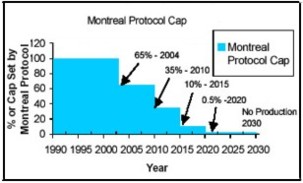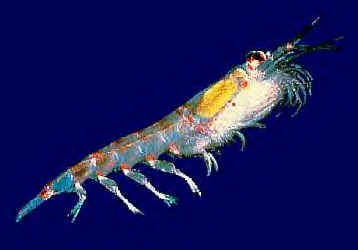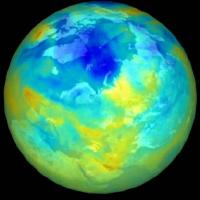Will the Proposed Solution (the Montreal Protocol) Achieve a Sustainable Scale?
A Partial Solution: Accomplishments
The Atmospheric Ozone Depletion story appears to be a simple case of problem identified, international agreement to solve problem, and problem solution implemented. The relative success of the Protocol is attributed to the clarity of the science involved (regarding both the causes and the consequences of ozone depletion), a strong political will, and most importantly, available substitutes for the troublesome compounds. Of course the reality was quite complicated, considerable damage was done to many living systems, and considerable negotiating skills were required to come to an agreement.
 The solution to the problem of atmospheric ozone depletion developed within the framework of the Montreal Protocol is close to what is required from a scale perspective – the total phasing out or ban of ozone depleting compounds. Phasing out of various compounds began in 1987 and is scheduled to be completed by 2030, but there is some leeway for developing countries and “essential uses.” International negotiations began with a partial reduction in emissions of ozone depleting compounds but as the scientific evidence of the damage done by the thinning of the ozone layer became clearer, a total ban was agreed as the goal.
The solution to the problem of atmospheric ozone depletion developed within the framework of the Montreal Protocol is close to what is required from a scale perspective – the total phasing out or ban of ozone depleting compounds. Phasing out of various compounds began in 1987 and is scheduled to be completed by 2030, but there is some leeway for developing countries and “essential uses.” International negotiations began with a partial reduction in emissions of ozone depleting compounds but as the scientific evidence of the damage done by the thinning of the ozone layer became clearer, a total ban was agreed as the goal.
What has been achieved by international agreement is a considerable reduction in the amount of ozone depleting compounds that are manufactured and in use. There also appears to be progress in terms of at least reducing the rate of anthropogenic atmospheric ozone depletion. These are major accomplishments which came about fairly quickly and with considerable effort. However, the solution to date falls short of achieving sustainable scale.
Solution Shortfalls from a Scale Perspective
In fact the ozone depletion problem is not solved, and at best some damage will continue for decades. Ozone depleting compounds (ODCs) are still being manufactured and used, and the atmospheric ozone layer remains considerably thinner than it was at the beginning of the last century. According to the latest assessment report it may never return to that earlier level.1
Continuing Risks
Thinking about scale requires us to consider both amounts of ODCs in the global economy and a variety of ecosystem impacts. It is clear that the optimal level of ODC throughput is zero or close to zero – any ODCs by definition upset the natural balance for atmospheric ozone. While the Montreal Protocol seems to have succeeded in reducing ODC production toward this sustainable scale target, a number of potential risks remain with regard to ecosystem services:
- The current planned reduction of ODCs may or may not succeed (political setbacks are possible)
- It is possible that yet unknown harmful consequences of UV-B exposure will be identified
- Potentially critical ecosystem services associated with the atmospheric ozone layer other than UV-B protection may be identified
- The impact of other scale problems as they might affect atmospheric ozone depletion.
Will the Montreal Protocol Succeed?
While the Montreal Protocol appears to be working, it will be decades at best before normal levels of atmospheric ozone are restored. There is no assurance that this is inevitable. The UN’s “Scientific Assessment of Ozone Depletion: 2002” report states “The ozone layer will remain particularly vulnerable during the next decade or so, even with full compliance.” The same report goes on to say “… because of changes in other influencing factors, such as changes in cloud cover, aerosols, or snow/ice cover, UV radiation may not return exactly to pre-ozone-hole values.” (italics added)
Many scientific and political uncertainties remain: new data are emerging regularly about the complex atmospheric processes involved; black market trading and production of some ODCs may be increasing; and the United States has recently asked for exemption from the phasing out of a known and previously agreed upon ODC - methyl bromide.
The longer the term over which the recovery must be managed, the more likely some geochemical or political event can retard or reverse the process. Just such a reversal occurred when the Reagan administration in the US relaxed restrictions on the sale of CFCs after they were initially banned. This led to increases in both CFC emissions and atmospheric ozone depletion. The ultimate impact of the actions taken on the sustainability of the atmospheric ozone layer will not be known for decades.
Black market trading in ozone depleting compounds is a serious problem. These materials are still freely available and cheap in developing countries but are becoming increasingly expensive in developed countries as stockpiles run down. Unscrupulous traders and criminals are diverting material from the former to the latter. In the US, for example, it has been estimated that approximately 10,000 tones of CFC have been smuggled in 1995 and 1996. In Miami, where the illegal trade was centered, illegal CFCs were second in street value only to crack cocaine.
The environmental costs are even greater as the incentive to swap to ozone-benign alternative technologies is undermined, supplies for legitimate developing world customers are diverted and CFCs continue to be released into the atmosphere. In 1994, the US Environmental Protection Agency (EPA) estimated that the cost of cleansing just the US of CFCs through to the year 2075 would be approximately US$34 billion but would be offset by the US$32 trillion cost in damages that would be avoided through preventing skin cancer, crop destruction and the like2.
UV-B Protection for What Ecosystem Functions?
Scientific understanding of the important role the atmospheric ozone layer plays in terms of UV-B protection is relatively new, stimulated in part by the discovery of ozone depletion. The various life support functions affected by UV-B protection are still being explored and new discoveries are likely. It is conceivable that some essential life support functions resulting from UV-B protection are more subtle, or take longer to express themselves, than the ones currently known. Sustainable scale may already have been exceeded for these ecosystem services but not yet been detected.
It is also possible that the continued exposure to UV-B radiation over the next few decades will result in exceeding sustainable scale for some critical ecosystem function. For example, the result of reduced UV-B protection could significantly affect the supply of ocean phytoplankton, and in turn the entire ocean food chain. The crucial role of atmospheric ozone in the evolution of life over hundreds of millions of years suggests such impacts are at least possible. It also underscores the importance of research into the basic life supports functions of global ecosystems.



Does the Atmospheric Ozone Layer Do More than Provide UV-B Protection?
The third kind of risk has to do with functions other than UV-B protection that the ozone layer might provide. We know that global ecosystems such as the atmospheric ozone layer are complex and usually provide a variety of services. Are there ecosystem functions (in addition to UV-B protection), that the atmospheric ozone layer provides either on its own or in conjunction with other ecosystems? Given the global nature of the atmospheric ozone layer, and its long term role in the evolution of most life-forms, this should at least be considered.
A potential implication is that we have already exceeded sustainable scale for some unknown but vital ecosystem function performed by this layer. When global systems are involved it would seem prudent to at least explore this issue. For example, could the role the atmospheric ozone layer plays in global climate regulation be limiting the climate’s ability to adapt to changing circumstances induced by rising greenhouse gas (GHG) concentrations?
How Might Other Scale Problems Affect Restoration of an Atmospheric Ozone Balance?
The fourth type of risk to be considered is how other global scale problems might impact the atmospheric ozone layer. The major global ecosystems  evolved together over billions of years and it is to be expected that they are intimately interconnected in complex ways. For example, a 2002 NASA study suggests that increases in various greenhouse gas (glossary) emissions are offsetting some of the improvements from reduction of ODCs.
evolved together over billions of years and it is to be expected that they are intimately interconnected in complex ways. For example, a 2002 NASA study suggests that increases in various greenhouse gas (glossary) emissions are offsetting some of the improvements from reduction of ODCs.
It is also reported that the increased greenhouse gas-induced warming of the lower stratosphere, where most of the ozone occurs, may be speeding up chemical reactions that destroy ozone by cooling the upper atmosphere. In addition, methane, also a greenhouse gas, may destroy atmospheric ozone independently of any warming effect (but anthropogenic sources are not named as a banned substance). The NASA study suggests that climate change may retard the anticipated recovery of atmospheric ozone expected from the Montreal Protocol.
The issues of ozone depletion and climate change are interconnected in many complex ways. On the one hand, the reduction of some ODCs will reduce the contributions of those compounds to greenhouse warming. On the other hand, increased use of their substitutes (e.g. hydro fluorocarbons or HFCs) will contribute to greenhouse warming. In addition, atmospheric ozone depletion acts to cool the climate system, so that successful recovery of the ozone layer will contribute to global warming.
Unusual weather events may contribute to ozone depletion (05 study of hole increase due to extreme cold over arctic). These complex interdependencies of global ecosystems are a major reason for ensuring that all such systems remain within sustainable scale, and point out the dangers of exceeding scale in any single area, never mind multiple areas at the same time. The longer the duration over which material throughput exceeds sustainable scale, the greater the likelihood of critical ecosystem disruptions.
In Summary
Despite the welcomed successes of the Montreal Protocol the level of atmospheric ozone depletion will continue to exceed sustainable scale for several decades. Damage to living things will continue as long as levels remain above sustainable scale. In addition, the possibility of atmospheric ozone depletion exceeding maximum scale with respect to some (yet undetected) ecosystem services cannot be ruled out. These remaining risks underscore the importance of policies and practices which emphasize the precautionary principle regarding any decisions which might affect a return of atmospheric ozone to traditional levels of sustainable scale. The variety, complexity, potential magnitude, and extended duration of these risks also highlight the importance of implementing policies to ensure sustainable scale is not exceeded in the first place.
Selected Readings
1"Scientific Assessment of Ozone Depletion: 2002." The Ozone Secretariat. United Nations Environment Programme.
http://www.unep.org/ozone/sap2002.shtml
2"New Challenges to the Montreal Protocol." Hayman, Gavin and S. Trent. Environmental Investigation Agency. http://www.unesco.org/education/educprog/ste/news;etter/eng_n2/newchall.html